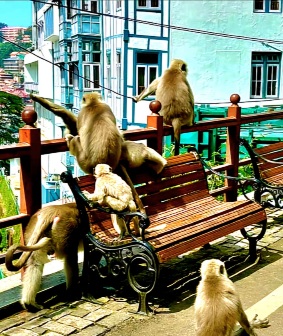A Tale of Two Monkeys in Shimla: The Red Rhesus and the Hanuman Langur
Shimla, the beautiful hill city, is home to two distinct species of monkeys – the red Rhesus macaque and the white-grey Hanuman Langur.
While they share the town's picturesque landscapes with locals and tourists alike, their behavior, habits, and impact on the city’s ecosystem are markedly different.
The red Rhesus macaque, often mistaken as descendants of the revered monkey god Hanuman, is actually a product of mutational changes and inbreeding. Unlike the majestic Langur, these monkeys are known for their aggressive behavior, especially when it comes to food.
Found frequently in Shimla’s bustling streets, they have become notorious for snatching eatables from unsuspecting tourists, children, and even women carrying bags.
With their boldness growing over time, these monkeys can often be seen raiding shops and homes, leading to frequent complaints from residents.
On the other hand, the Hanuman Langur, also known as the "leaf-eating monkey," is considered a more dignified and less intrusive resident of Shimla.
These monkeys, may be loosely and believably termed as descendants of God Hanuman, are large, weighing up to 20kg, and maintain a diet primarily of leaves and fruits.
Unlike the Rhesus macaque, Langurs live in close-knit family groups and are rarely seen causing trouble in public spaces.
They are neat, clean, and far less dependent on human food, showing little interest in interacting with the urban environment.
Their powerful leaps and graceful movements can be seen in the city’s quieter corners, but they seldom come into the streets to demand food.
While Shimla wouldn’t quite be the same without these primates, the Rhesus macaques have become a growing nuisance, particularly for tourists who often fall victim to their aggressive food-snatching.
Meanwhile, the Hanuman Langur, with its more reserved demeanor, remains a symbol of the city’s natural charm, adding a touch of the wild without the chaos.
For many, both species are a form of entertainment, providing visitors with a glimpse into nature.
But for others, particularly those vulnerable to the Rhesus monkeys' attacks, navigating the streets of Shimla has become a careful balancing act, ensuring that food and belongings are kept securely out of sight.
Without these monkeys, Shimla might lose part of its wild character, but finding a solution to the growing conflict between humans and the Rhesus macaques is becoming increasingly urgent.







